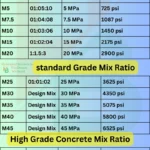How Land is Measured in India
Table of Contents
ToggleSmall Tracts or Residential Plots:
- Square Feet (sq ft): This unit is commonly used for measuring small plots or residential areas. 1 sq ft is approximately 0.0929 square meters.
- Square Metres (sq m): Similar to square feet, square meters are used for smaller land areas. 1 sq m is equivalent to 10.764 square feet.
Large Tracts, Industrial, or Agricultural Land:
- Acres: This unit is prevalent for measuring large expanses of land, especially in the context of agriculture or industrial use. 1 acre is about 4,047 square meters or 0.4047 hectares.
- Hectares: Widely used globally and in specific contexts in India, 1 hectare equals 10,000 square meters.
Regional Units in Villages:
- Bigha: A traditional unit with variations across states. The size of 1 Bigha can vary, with different regions having different conversion factors.
- Guntha: Commonly used in Maharashtra and Gujarat, 1 Guntha is about 1,089 square feet.
- Ground: Used in Karnataka, the size of 1 Ground can vary but is often around 2,400 square feet.
- Gaj: Typically used in North India, 1 Gaj is equivalent to 9 square feet.
Understanding these units is crucial for anyone involved in real estate transactions in India, ensuring accurate measurements and facilitating smooth transactions, especially in regions where traditional units are prevalent.
Plot vs. Ground:
A “plot” is a designated piece of land, often for specific purposes like construction. “Ground” is a broader term for any land area, developed or not.
Plot vs. Site:
While “plot” refers to a specific land area, “site” is a broader term encompassing locations or areas, not necessarily demarcated for a specific purpose.
Land vs. Ground:
“Land” is a general term for the Earth’s surface. “Ground” is a specific piece of land, often used in a property context, indicating a localized area.
Common land measurement units in India
| Land Measurement Unit | Equivalent in Square Feet (sq ft) |
|---|---|
| Square Feet (sq ft) | 1 sq ft = 1 sq ft |
| Square Centimeters (sq cm) | 1 sq cm ≈ 0.00107639 sq ft |
| Square Inch (sq in) | 1 sq in ≈ 0.0069444 sq ft |
| Square Kilometer (sq km) | 1 sq km ≈ 247.1 acres |
| Square Meter (sq m) | 1 sq m ≈ 11 sq ft |
| Square Mile | 1 sq mile ≈ 640 acres or 259 hectares |
| Square Yard (sq yd) | 1 sq yd ≈ 9 sq ft |
| Acre | 1 acre ≈ 4840 sq yd or 100.04 cents (standard unit for land measurement) |
| Hectare | 1 hectare ≈ 10000 sq m or 2.49 acres approximately |
| Bigha | 1 Bigha ≈ 1,012 sq m |
| Biswa | 1 Biswa ≈ 151.25 sq yd |
| Killa | 1 Killa ≈ 4,047 sq m |
| Kanal | 1 Kanal ≈ 5,445 sq ft or 605 sq yd |
| Chatak | 1 Chatak = 180 sq ft |
| Kattha | 1 Kattha = 545 sq ft |
standard land area units
- Hectare:
- Commonly used for measuring forest or agricultural lands.
- Utilized in estate evaluation and town planning.
- Acres:
- Popularly used in the United States of America and the United Kingdom.
- Also used in India, particularly for measuring large areas like estates or farmland.
- Bigha:
- Commonly used in Indian States such as Punjab, Bihar, Uttar Pradesh, Haryana, Himachal Pradesh, Uttarakhand, Rajasthan, and Gujarat.
- No standard size; measurement units vary by state.
- Example: In Uttarakhand, one Bigha is 756.222 sq yd, while in West Bengal, it equals 1,600 sq yd.
- Square Foot:
- Widely used worldwide, an imperial and US customary unit of area.
- Commonly used in the US and partially in Canada.
- Ground:
- Commonly used in the southern State of Tamil Nadu.
- One ground is equivalent to 203 sq m or 24,000 sq ft.
- Square Meter:
- Standard International (SI) unit of area measurement.
- Denoted as sq m or m2.
- Katha:
- Popularly used in the eastern states of India.
- No standard size; varies by region.
- Example: In West Bengal, one katha equals 720 sq ft, while in Bihar, it is 1,361.25 sq ft.
Converting Biswa to Acres
Biswa is commonly used as a land measurement unit in Delhi, Jammu and Kashmir, Rajasthan, Haryana and Himachal Pradesh. Below is the process to convert a land measured in Biswa into acres for standardization: For easier calculation, you may use 99acres area converter. However, in manual conversion, 1 Biswas is 0.03099 acres. Suppose the land area is 75,000 units of land in Biswa, which needs to be converted into acres; you can multiply it by 0.03099. 75,000 Biswa units of land x 0.03099 = 2,324.25 acresConverting sq ft to gaj
The most commonly used term for real estate land measurements in India is sq ft. However, in many parts of North India, people prefer the measurements in gaj for better understanding. Here is the formula to convert area from sq ft to sq gaj:- Converting Acres to Square Meters:
- Conversion Factor: 1 acre ≈ 4046.86 square meters.
- Example Calculation: If the land area is 5 acres, the conversion to square meters would be: 5 acres x 4046.86 = 20,234.3 square meters.
- Converting Hectares to Square Feet:
- Conversion Factor: 1 hectare ≈ 107,639.1 square feet.
- Example Calculation: If the land area is 2 hectares, the conversion to square feet would be: 2 hectares x 107,639.1 = 215,278.2 square feet.
- Converting Square Yards to Square Meters:
- Conversion Factor: 1 square yard ≈ 0.836127 square meters.
- Example Calculation: If the land area is 500 square yards, the conversion to square meters would be: 500 square yards x 0.836127 = 418.064 square meters.
- Converting Bigha to Square Kilometers:
- Bigha Usage: Commonly used in Indian states like Bihar, Uttar Pradesh, and West Bengal.
- Conversion Factor: 1 Bigha ≈ 0.004047 square kilometers.
- Example Calculation: If the land area is 10 Bigha, the conversion to square kilometers would be: 10 Bigha x 0.004047 = 0.04047 square kilometers.
- Converting Biswa to Acres:
- Biswa Usage: Commonly used in Delhi, Jammu and Kashmir, Rajasthan, Haryana, and Himachal Pradesh.
- Conversion Factor: 1 Biswa = 0.03099 acres.
- Example Calculation: If the land area is 75,000 Biswa, the conversion to acres would be: 75,000 Biswa x 0.03099 = 2,324.25 acres.
- Converting sq ft to Gaj:
- sq ft Usage: Widely used term for real estate land measurements in India.
- Conversion Factor: 1 sq ft ≈ 0.112 sq gaj.
- Example Calculation: If the land area is 1,340 sq ft, the conversion to sq gaj would be: 1,340 / 0.112 = 150.33 sq gaj.
Role and Responsibilities of Revenue Officers in Indian Land Administration
**1. Tehsildar:
- Role: Holds a pivotal position in land record management.
- Responsibilities:
- Reports crop losses and related issues to higher authorities.
- Oversees revenue inspectors and ensures effective land administration.
2. Naib Tehsildar:
- Role: Assists the Tehsildar, playing a crucial role in land record maintenance.
- Responsibilities:
- Manages multiple revenue circles in a State, reporting to the Tehsildar.
- Supervises crop yield inspections and regional record maintenance.
3. Revenue Inspector:
- Role: Acts as a key assistant to Naib Tehsildars and Tehsildars in land record management.
- Responsibilities:
- Certifies mutations and boundary marks.
- Surveys damages caused by natural calamities and prepares inspection reports.
4. Patwari:
- Role: Integral to land administration, responsible for managing land records in specific areas.
- Responsibilities:
- Maintains village land records and ensures their accuracy.
- Measures fallow and agricultural land, updating records regularly.
- Manages crop records and assists in various land-related tasks.





